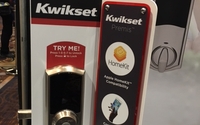 One of the key insights from CES this year is that the pieces of The
Internet of Things are starting to be made to work with each other.
One of the key insights from CES this year is that the pieces of The
Internet of Things are starting to be made to work with each other.
At the last two CES annual events, smart objects tended to operate in more of a standalone approach.
A smart
lightbulb could be controlled by the app related to that bulb or a smart lock could lock or unlock a door via that company’s smartphone app.
Many of the objects were Internet-connected,
but tended to represent islands of connected objects.
This made total sense at the time, since some of the IoT platforms of the major companies were but blips on the radar.
What struck
me at CES this year is the massive wave from smart or connected objects to interconnected objects.
The IoT islands are being linked together.
For example, the Kwikset lock
allows a person to unlock their door via the Kwikset app, but the lock system is totally compatible with Apple HomeKit.
Well-known lock maker Schlage showed smart locks that integrate with
other smart home systems, which control features such as lighting and appliances. Schlage locks now link with Apple HomeKit and soon with Android systems and the Apple Watch.
Light-maker
Lutron introduced remote controlled shades, which work with connected home capabilities provided by Apple, Honeywell, Android, Alarm.com and many others.
Security systems from Alarm.com now
tie in with Apple as well as other indoor camera and door lock systems from other companies.
Plantronics, well known for many years for its quality headsets, introduced Bluetooth smart
headsets that add a second authentication for mobile payments, integrated with NFC and Gemalto security.
The Bluetooth headset has enhanced motion tracking and, formerly a headset that simply
provided hands-free listening and talking for a conversation by a user, is transformed to a location-based device that triggers and authorizes actions based on location and context.
The
implications of this are that a consumer wearing a wireless headset in their home could use voice commands to turn lights on and off, change temperature and manage smart appliances, adding an entirely
new dimension to the power of voice.
Not all companies will get this.
Those companies will remain as islands by themselves, isolated from The Internet of Everything, which is moving on
and getting in synch with itself.